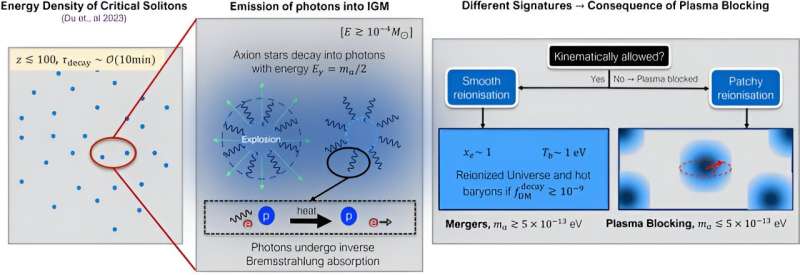We could be closer to understanding the mystery behind what dark matter is, following new research from physicists at King’s College London.
First theorized in 1977, axions are a hypothetical, light-mass particle that have been suggested as a possible contender for dark matter, due to the heat they give off. However, due to the range of sizes and masses they could possibly be, their conclusive identification has been difficult.
In a series of papers in Physical Review D, Liina Chung-Jukko, Professors Malcolm Fairbairn, Eugene Lim, Dr. David Marsh and collaborators have suggested a new approach to locate this ‘wonder particle’ that could explain both dark energy and dark matter.
Professor Malcolm Fairbairn explains, “Axions are one of the prime candidates for dark matter. We discovered that they have the capacity to heat the universe just like supernovae and ordinary stars after coming together in dense clumps. Armed with that knowledge, we know with far more certainty where to point our instruments out in the field to find them.”
Einstein’s theory of general relativity suggests that around 85% of the material in the universe is dark matter—an unknown form of matter we’ve been unable to observe or probe. Gravitational effects, observed in scenarios like the formation of galaxies, don’t make sense within Einstein’s model unless there is a large amount of matter that we can’t see and that doesn’t interact with light or electromagnetic fields.
Axions are a contender for this hypothetical form of matter. These low-mass particles must be present in very large numbers to explain the missing mass in galaxies. As these axions must exist in large numbers, they must also be packed densely in specific areas, meaning they become subject to the laws of quantum mechanics.
This would mean individual axions would begin to act in concert. That would mean that there could be large groupings of axion dark matter at the center of galaxies, otherwise known as “axion stars.”

These axion stars can become unstable past a certain mass threshold, exploding into electromagnetic radiation and photons—particles of light, as shown in more detail by Liina Chung-Jukko. The scientists suggest that these explosions have the potential to have heated the intergalactic gas that exists between galaxies in the time separating the big bang and the formation of the first stars, 50–500 million years after the beginning of the universe.
This would change the way that cosmic background radiation (CMB)—the electromagnetic radiation that fills all space—would look like during this period, which scientists can currently observe through radio waves using a method called 21cm measurement.
By looking for signals of where axion stars exploded in the early or present universe in this way, scientists may be able to use these methods to track down the so far unobserved axion and discover the source of some, if not all, dark matter.
Malcolm Fairbairn said, “Coherent axion stars, even those which are relatively compact, have the potential to burst into a halo of electromagnetism and light. Knowing the kind of structures axion dark matter can form and its impact on surrounding intergalactic gas, can pave new ways for its detection.
“Being able to find the axion would likely help us solve one of science’s biggest questions, over a century in the making, and help lay bare the history of the early universe.”
By computing the total number of axion stars in the universe, and by extension their latent explosive potential on intergalactic gas, the team have also surmised the size of the signal axion stars would give out in the CMB. This would allow 21cm measurements to categorize what is and what isn’t originating from axions accurately, aiding in the search.
The work from King’s joins a growing chorus among the scientific community searching for the axion as the prime contender for dark matter, David Marsh said, “21cm measurement is generally seen as the future of cosmology, and the part that it plays in the search for the axion is a large reason for that. There is currently a huge proliferation of axion searches being built, including projects like Dark Matter Radio. It is a very, very exciting time to be an astrophysicist right now.”
More information:
Miguel Escudero et al, Axion star explosions: A new source for axion indirect detection, Physical Review D (2024). DOI: 10.1103/PhysRevD.109.043018
Xiaolong Du et al, Soliton merger rates and enhanced axion dark matter decay, Physical Review D (2024). DOI: 10.1103/PhysRevD.109.043019
Provided by
King’s College London
Citation:
New research suggests explosive ‘axion stars’ could pinpoint where and what dark matter is (2024, February 26)
retrieved 26 February 2024
from
This document is subject to copyright. Apart from any fair dealing for the purpose of private study or research, no
part may be reproduced without the written permission. The content is provided for information purposes only.